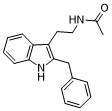| Cas No.: | 117946-91-5 |
| Chemical Name: | Luzindole |
| Synonyms: | Acetamide,N-[2-[2-(phenylmethyl)-1H-indol-3-yl]ethyl]-;Luzindole;N-[2-(2-benzyl-1H-indol-3-yl)ethyl]acetamide;N-Acetyl-2-benzyl-tryptamine;N<;2-Benzyl-N-acetyltryptamine;Arachidonyl serotonin;N-0774;N-Acetyl-2-benzyltryptamine;N-Acetyl-2-benzyltryptamine N-[2-[2-(Phenylmethyl)-1H-indol-3-yl]ethyl]acetamide;Tocris-0877;N-[2-[2-(Phenylmethyl)-1H-indol-3-yl]ethyl]acetamide;N 0774;Luzindole Solution, 100ppm;LuzindoleN-Acetyl-2-benzyltryptamine;N-(2-(2-benzyl-1H-indol-3-yl)ethyl)acetamide;N-[2-[2-(Phenylmethyl)-1H-indol-3-yl]ethyl]acetamide, N-Acetyl-2-benzyltryptamine;AcetaMide, N-[2-[2-(phenylMethyl)-1H-indol-3-yl]ethyl]-;Luzindole, >=90%;AMOT0032;GTPL1363;BDBM85065;HMS3411B10;HMS3266N04;Acetamide, N-(2-(2-(phenylmethyl)-1H-indol-3-;B31Y10A9UR;Acetamide, N-(2-(2-(phenylmethyl)-1H-indol-3-yl)ethyl)-;HMS326;LUZINDOLE;N-ACETYL-2-BENZYLTRYPTAMINE;2-Benzyl-N-acetyltryptaMine;n-[2-[2-(phenylmethyl)-1h-indol-3-yl]ethyl]acetamide |
| SMILES: | O=C(C([H])([H])[H])N([H])C([H])([H])C([H])([H])C1C2=C([H])C([H])=C([H])C([H])=C2N([H])C=1C([H])([H])C1C([H])=C([H])C([H])=C([H])C=1[H] |
| Formula: | C19H20N2O |
| M.Wt: | 292.3749 |
| Purity: | 98% |
| Sotrage: | 2 years -20°C Powder, 2 weeks 4°C in DMSO, 6 months -80°C in DMSO |
| Description: | Luzindole (N-0774) is a selective melatonin receptor antagonist. Luzindole preferentially targets MT2 (Mel1b) over MT1 (Mel1a) with Ki values of 10.2 and 158 nM for human MT2 and MT1, respectively. Luzindole suppresses experimental autoimmune encephalomyelitis (EAE), and exerts antidepressant-like activity[1][2][3]. |
| Target: | Ki :10.2 nM (human MT2), 158 nM (human MT1)[1] |
| In Vivo: | Luzindole (N-0774) (30 mg/kg; i.p.; days 0-5) suppresses experimental autoimmune encephalomyelitis[2]. Luzindole (N-0774) (30 mg/kg i.p.) reduces the time of immobility in a dose-dependent manner, the effect being more pronounced at midnight (60% reduction) than at noon (39% reduction). The effect of luzindole is time-dependent, showing a maximal effect at 60 min. The anti-immobility effect of luzindole (10 mg/kg i.p.) is prevented by the administration of melatonin (30 mg/kg i.p.). Luzindole (30 mg/kg i.p.) did not modify the time of immobility either at noon or midnight in the albino ND/4 mouse, or in the C57BL/6J mouse, which does not produce melatonin[3]. Animal Model: Twenty-three- to 12-week-old(SJL X PL/J ) F1 mice[2] Dosage: 30 mg/kg Administration: i.p.; days 0-5 (between 23: 00 and 1: 00 under conditions of minimal lighting) Result: Effectively prevented experimental autoimmune encephalomyelitis. |
| In Vitro: | Luzindole (N-0774) (5-10 μg/ml) inhibits antigen-specific proliferation of the MBP-reactive LV-4 T cell line[1]. |
| References: | [1]. Dubocovich ML, et al. Melatonin receptor antagonists that differentiate between the human Mel1a and Mel1b recombinant subtypes are used to assess the pharmacological profile of the rabbit retina ML1 presynaptic heteroreceptor. Naunyn Schmiedebergs Arch Pharmacol. 1997 Mar;355(3):365-75. [2]. Constantinescu CS, et al. Luzindole, a melatonin receptor antagonist, suppresses experimental autoimmune encephalomyelitis. Pathobiology. 1997;65(4):190-4. [3]. Dubocovich ML Antidepressant-like activity of the melatonin receptor antagonist, luzindole (N-0774), in the mouse behavioral despair test. Eur J Pharmacol. 1990 Jul 3;182(2):313-25. |

 DC Chemicals' products qualify for U.S. tariff exemptions. We guarantee no price increases due to customs duties and maintain stable supply, continuing to deliver reliable research solutions to our American clients.
DC Chemicals' products qualify for U.S. tariff exemptions. We guarantee no price increases due to customs duties and maintain stable supply, continuing to deliver reliable research solutions to our American clients.





















